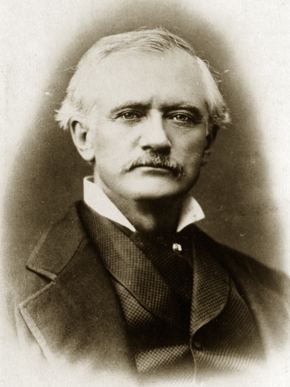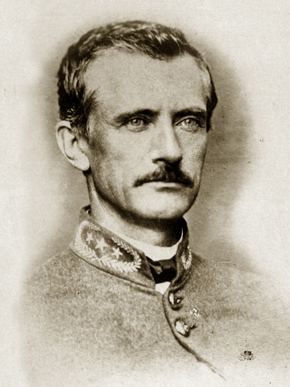Preceded by George Goldthwaite Name John Morgan Years of service 1861–1865 Role U.S. senator | Rank Brigadier General Succeeded by John H. Bankhead Battles/wars American Civil War | |
 | ||
Born June 20, 1824
Athens, Tennessee ( 1824-06-20 ) Allegiance Confederate States of America Service/branch Confederate States Army Died June 11, 1907, Washington, D.C., United States | ||
Battles and wars American Civil War | ||
John Tyler Morgan | Wikipedia audio article
John Tyler Morgan (June 20, 1824 – June 11, 1907) was a general in the Confederate States Army during the American Civil War, a six-term U.S. senator from the state of Alabama after the war. An ardent racist and ex-slave holder, he was a proponent of Jim Crow laws, states rights and racial segregation through the Reconstruction era. He was an expansionist, arguing for the annexation of the Republic of Hawaii against the native population's will and for U.S. construction of an inter-oceanic canal in Central America.
Contents
- John Tyler Morgan Wikipedia audio article
- Early life and career
- Civil War
- Postbellum career
- Foreign policy
- Death and legacy
- Memorialization
- References

Early life and career
Morgan was born in Athens, Tennessee into a family of Welsh origin whose ancestor, James B. Morgan (1607–1704), settled in the Connecticut Colony. John T. Morgan was initially educated by his mother. In 1833, he moved with his parents to Calhoun County, Alabama, where he attended frontier schools and then studied law in Tuskegee with justice William Parish Chilton, his brother-in-law. After admission to the bar he established a practice in Talladega. Ten years later, Morgan moved to Dallas County and resumed the practice of law in Selma and Cahaba.
Turning to politics, Morgan became a presidential elector on the Democratic ticket in 1860, and supported John C. Breckinridge. He was delegate from Dallas County to the State Convention of 1861, which passed the ordinance of secession.
Civil War
With Alabama's vote to leave the Union, at the age of 37 Morgan enlisted as a private in the Cahaba Rifles, which volunteered its services in the Confederate Army and was assigned to the 5th Alabama Infantry. He first saw action at the First Battle of Manassas in the summer of 1861. Morgan rose to major and then lieutenant colonel, serving under Col. Robert E. Rodes, a future Confederate general. Morgan resigned in 1862 and returned to Alabama, where in August he recruited a new regiment, the 51st Alabama Partisan Rangers, becoming its colonel. He led it at the Battle of Murfreesborough, operating in cooperation with the cavalry of Nathan Bedford Forrest.
When Rodes was promoted to major general and given a division in the Army of Northern Virginia, Morgan declined an offer to command Rodes's old brigade and instead remained in the Western Theater, leading troops at the Battle of Chickamauga. On November 16, 1863, he was appointed as a brigadier general of cavalry and participated in the Knoxville Campaign. His brigade consisted of the 1st, 3rd, 4th (Russell's), 9th, and 51st Alabama Cavalry regiments.
His men were routed and dispersed by Federal cavalry on January 27, 1864. He was reassigned to a new command and fought in the Atlanta Campaign. Subsequently, his men harassed William T. Sherman's troops during the March to the Sea. Later, he was assigned to administrative duty in Demopolis, Alabama. When the Confederacy collapsed and the war ended, Morgan was trying to organize Alabama black troops for home defense.
Postbellum career
After the war, Morgan resumed the practicing of law in Selma, Alabama. According to insider information, after the death of James H. Clanton in 1872, Morgan allegedly succeeded him as the Grand Dragon of the Ku Klux Klan in Alabama, but other than a personal account, there is no physical or historical evidence of this. He was once again presidential elector on the Democratic ticket in 1876 and was elected as a Democrat to the United States Senate in that year, being re-elected in 1882, 1888, 1894, 1900, and 1906, and serving from March 4, 1877, until his death. For much of his tenure, he served as Senator alongside a fellow former Confederate general, Edmund W. Pettus.
Morgan advocated for separating blacks and whites in the U.S. by encouraging the migration of black people out of the U.S. south. Hochschild wrote, "at various times in his long career Morgan also advocated sending them [negroes] to Hawaii, to Cuba, and to the Philippines - which, perhaps because the islands were so far away, he claimed were a "native home of the negro."
Morgan also staunchly worked for the repeal of the Fifteenth Amendment to the U.S. Constitution that was intended to prevent the denial of voting rights based on race. He was chairman of Committee on Rules (Forty-sixth Congress), the Committee on Foreign Relations (Fifty-third Congress), the Committee on Interoceanic Canals (Fifty-sixth and Fifty-seventh Congresses), and the Committee on Public Health and National Quarantine (Fifty-ninth Congress).
Foreign policy
In 1887-1907 Morgan played a leading role on the powerful Foreign Relations Committee. He called for a canal linking the Atlantic and Pacific oceans through Nicaragua, enlarging the merchant marine and the Navy, and acquiring Hawaii, Puerto Rico, the Philippines, and Cuba. He expected Latin American and Asian markets would become a new export market for Alabama's cotton, coal, iron, and timber. The canal would make trade with the Pacific much more feasible, and an enlarged military would protect that new trade. By 1905, most of his dreams had become reality, with of course the canal going through Panama instead of Nicaragua.
In 1894, Morgan chaired an investigation, known as the Morgan Report into the Hawaiian Revolution which concluded that the U.S. had remained completely neutral in the matter. He authored the introduction to the Morgan Report based on the findings of the investigative committee.
He was a strong supporter of the annexation of Hawaii and visited Hawaii in 1897 in support of annexation. He believed that the history of the U.S. clearly indicated it was unnecessary to hold a plebiscite in Hawaii as a condition for annexation. He was appointed by President William McKinley in July 1898 to the commission created by the Newlands Resolution to establish government in the Territory of Hawaii. A strong advocate for a Central American canal, Morgan was also a staunch supporter of the Cuban revolutionaries in the 1890s.
Death and legacy
Senator Morgan died in Washington, D.C. while still in office. He was buried in Live Oak Cemetery in Selma, Alabama. The remainder of his term was served by John H. Bankhead.
An article by history professor Thomas Adams Upchurch in the April 2004 Alabama Review says:
His congressional speeches and published writings demonstrate the central role that Morgan played in the drama of racial politics on Capitol Hill and in the national press from 1889 to 1891. More importantly, they reveal his leadership in forging the ideology of white supremacy that dominated American race relations from the 1890s to the 1960s. Indeed, Morgan emerged as the most prominent and notorious racist ideologue of his day, a man who, as much as any other individual, set the tone for the coming Jim Crow era.
In 1908, the Congressman from Alabama, Mr. James Thomas Heflin, in describing both recently deceased Senators Edmund Pettus and John Tyler Morgan said the following,
the ballot, that which represented privileges and powers for which the quick-witted Celt and the thoughtful Saxon had struggled a thousand years to achieve, was given in the twinkling of an eye to the unfit hordes of an inferior race. . . .No two men in Alabama, or in the South, did more to stay the hideous tide of negro domination than the two dearly beloved Senators whose death the House mourns to-day. In the dark and trying days of reconstruction these two men were foremost among the defenders of Anglo-Saxon civilization.
